Hong Kong exhibit at Venice Biennale explores ties with Pearl River Delta
Hong Kong's exhibition at the Venice Biennale explains how our changing relationship with the delta region has influenced architecture on both sides of the border, writes Christopher DeWolf

Halfway through director Heiward Mak Hei-yan's short film, , actor Eric Tsang Chi-wai takes a tumble in front of a billboard in Shenzhen's Qianhai development zone. "Supported by Hong Kong, serving the mainland, facing the world," it reads, reflecting the district's goal of attracting 100,000 Hong Kong permanent residents to live and work there.
Tsang plays Lee To, a Hongkonger who retires to Qianhai, where he falls in love with Lady Cheung, a Shenzhen native whose oyster farming village was cleared for land reclamation. In one intimate scene, Cheung (played by Taiwanese actress Kelly Tien Niu) asks Lee if he misses living in Hong Kong. "I can't really say," he replies. "Hong Kong is not my home any more."
is a story of alienation and ambiguity: Lee and Cheung live in spacious, comfortable apartments, but they are surrounded by vast construction sites and cut off from their families. Their romance seems to be as much a salve for loneliness as it is based on any kind of mutual attraction.
"They're wondering: What am I looking for?" says Mak.
It's a natural project for Mak, whose acclaimed 2008 debut, , dealt with a similar kind of rootlessness. ² made its debut in faraway Italy, where Hong Kong is participating in the 14th Venice Biennale of Architecture, the world's largest and most venerable showcase of the built form. Forty countries have mounted exhibitions in the biennale, which runs from June 7 to November 23.
This edition of the biennale is one of the most highly anticipated in years. Curated by iconoclast Dutch architect Rem Koolhaas, it eschews the biennale's traditional focus on "starchitects" and looks instead at architecture itself, raising questions about diminishing influence in the face of technology and broad economic forces. It also tackles architecture's thorny relationship with modernity and the extent to which it actually serves human needs.
